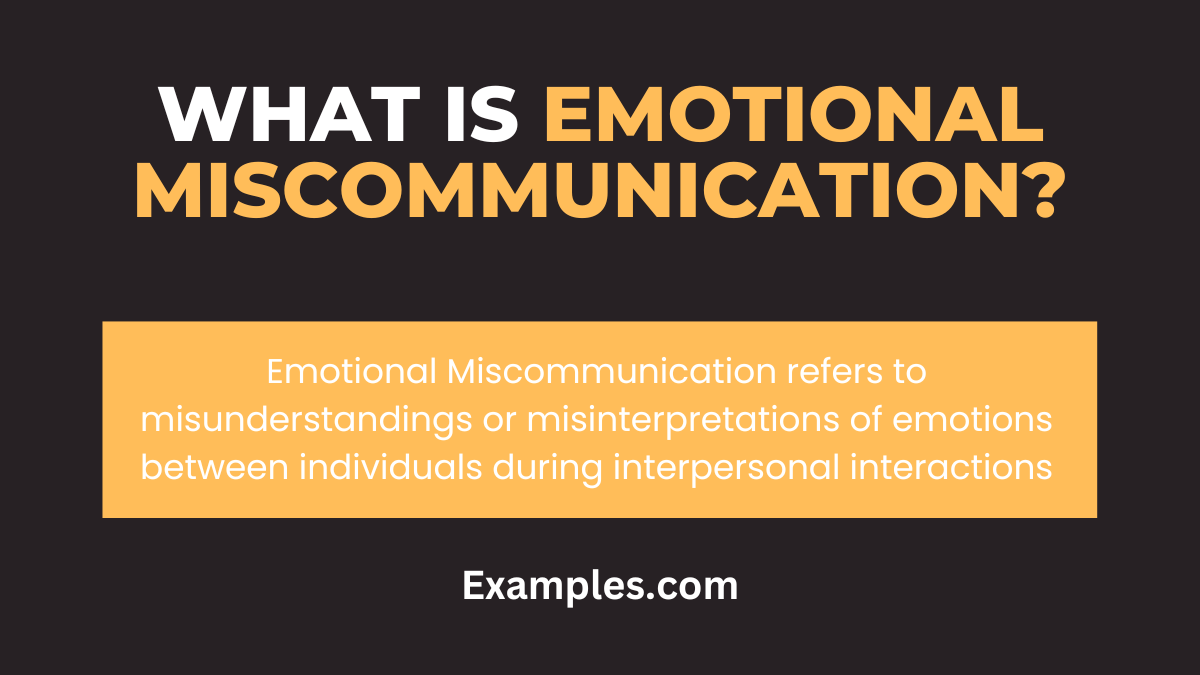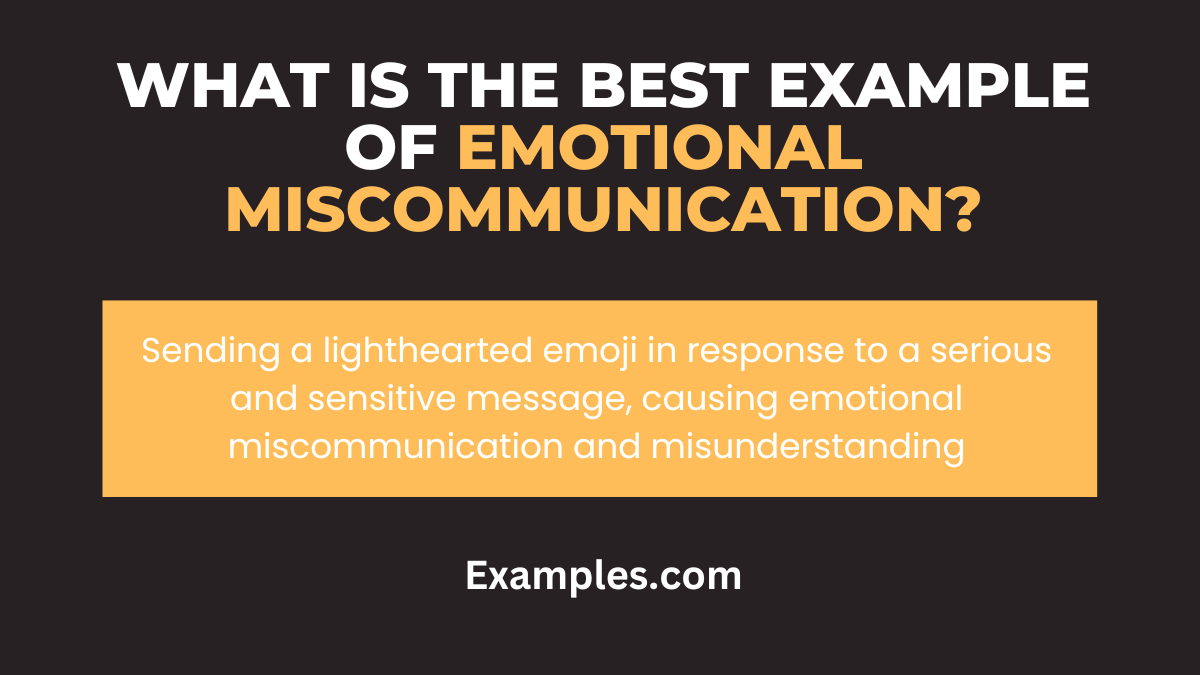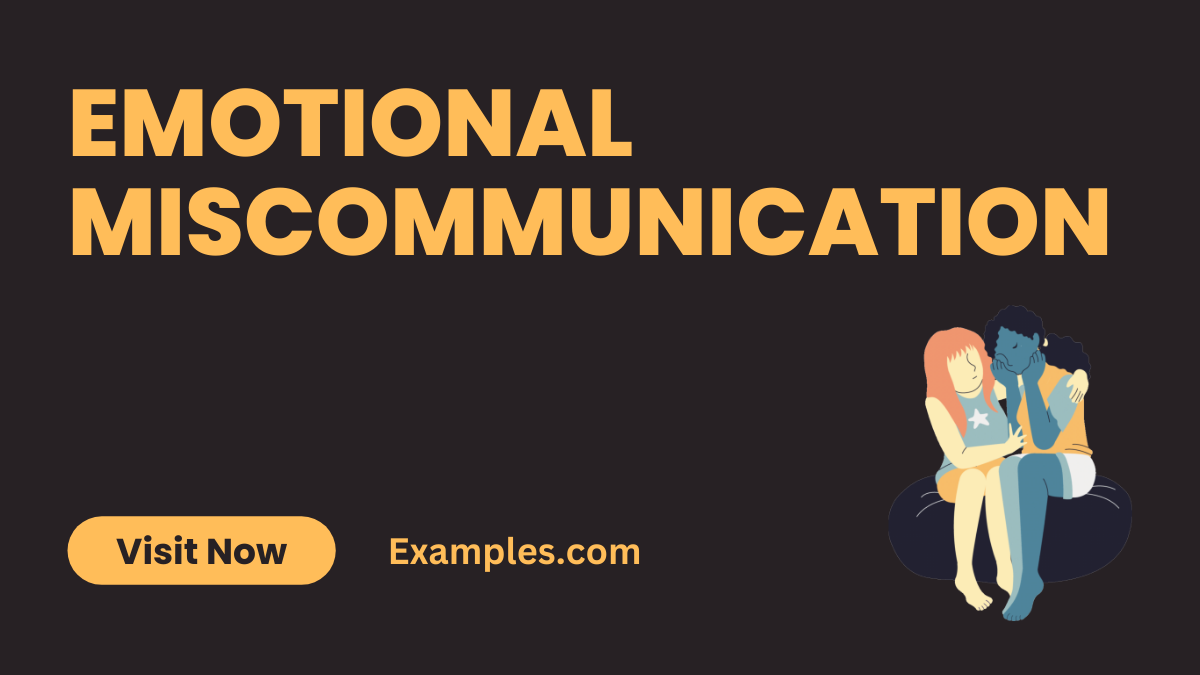19+ Emotional Miscommunication Examples
Emotional Miscommunication often lies at the heart of many relationship challenges, both personal and professional. It arises when our feelings, intentions, or needs are misunderstood or incorrectly conveyed. This guide delves into the complexities of emotional miscommunication, offering insights into its causes, manifestations, and resolutions. Understanding emotional miscommunication is crucial for building stronger, more empathetic connections. By recognizing and addressing these misunderstandings, we can foster deeper, more meaningful interactions in every aspect of our lives.
What is Emotional Miscommunication?

Emotional miscommunication occurs when there is a disconnect between what we feel and what we express, leading to misunderstandings in our interactions. It can stem from differences in communication styles, assumptions, or emotional states, impacting both personal and professional relationships.
What is the Best Example of Emotional Miscommunication?

A classic example of emotional miscommunication is in romantic relationships when partners misinterpret each other’s actions or words due to differing emotional needs or expectations. This can lead to conflicts, hurt feelings, and a sense of being misunderstood.
20 Examples of Emotional Miscommunication
Emotional miscommunication occurs when the feelings or emotions intended by the sender are not accurately understood by the receiver. This often leads to misunderstandings, hurt feelings, and strained relationships. Recognizing these examples is crucial for effective communication and emotional intelligence. Here, we explore 20 distinct examples of emotional miscommunication, each accompanied by a brief explanation and sample communication sentences, highlighting how subtle changes in expression can make a significant difference.
- Assuming anger instead of stress: Mistaking a partner’s stress for anger can escalate conflicts.
Example: “I thought you were mad at me, but I realize now you were just stressed about work.” - Misinterpreting silence for indifference: Silence is often perceived as a lack of interest.
Example: “Your silence made me feel ignored, but I understand now that you needed time to process.” - Confusing excitement with insensitivity: In times of shared grief, one’s excitement about an unrelated topic can seem insensitive.
Example: “I thought you didn’t care about our loss, but you were just trying to lighten the mood.” - Reading worry as distrust: Expressing worry can sometimes be misconstrued as a lack of trust.
Example: “I mistook your concern for a lack of trust in me.” - Interpreting enthusiasm as overbearing: Enthusiasm in a project can be seen as being controlling. Example: “I saw your enthusiasm as taking over, but I see now you were just excited about the project.”
- Mistaking shyness for arrogance: Shy behavior can be misread as aloofness or arrogance.
Example: “I thought you were being standoffish, but I understand now you’re just shy.” - Seeing assertiveness as aggression: Assertive communication can be misperceived as aggressive. Example: “I mistook your assertiveness for anger, which wasn’t your intention.”
- Confusing concern with control: Showing concern can sometimes be viewed as trying to control someone. Example: “I felt controlled when you expressed concern, but I realize now you were just worried about me.”
- Misreading patience as disinterest: Patience in listening can sometimes be misunderstood as lack of interest.
Example: “Your quiet listening seemed like disinterest, but I appreciate your patience now.” - Interpreting empathy as pity: Genuine empathy can be mistaken for pity.
Example: “I thought you pitied me, but I see now it was empathy.” - Mistaking passion for anger: Passionate expression can be misinterpreted as anger.
Example: “I misconstrued your passion for anger, I understand better now.” - Seeing sensitivity as weakness: Emotional sensitivity can be wrongly perceived as a lack of strength. Example: “I saw your tears as a weakness, but now I see your strength in being vulnerable.”
- Confusing frankness with rudeness: Being straightforward can sometimes be taken as rudeness. Example: “I took your frankness for rudeness, which wasn’t fair.”
- Reading nervousness as lack of confidence: Nervous behavior can be misinterpreted as a lack of confidence.
Example: “I mistook your nervousness for uncertainty, but I see your capability now.” - Misinterpreting generosity for ulterior motives: Acts of kindness can be seen as having hidden agendas.
Example: “I thought your help had strings attached, but I see now it was just generosity.” - Seeing curiosity as nosiness: Genuine curiosity can be mistaken for intrusiveness.
Example: “I felt you were prying, but now I understand you were just curious.” - Mistaking friendliness for flirtation: Friendly behavior can be misconstrued as romantic interest. Example: “I misread your friendliness as flirtation, my apologies for the misunderstanding.”
- Interpreting excitement as lack of seriousness: Being excited can be seen as not taking things seriously. Example: “I thought you weren’t serious because of your excitement, but I understand your perspective now.”
- Reading calmness as detachment: A calm demeanor can be misread as being detached or uncaring. Example: “Your calmness seemed like indifference, but I appreciate your composed approach.”
- Confusing compassion with overstepping boundaries: Expressing compassion can sometimes be seen as crossing personal boundaries.
Example: “I felt you were overstepping, but now I see it was genuine compassion.”
Emotional Miscommunication in the Workplace
- Unclear Expectations: Often, miscommunication arises when expectations or instructions are not clearly defined.
- Diverse Emotional Intelligence: Different levels of emotional intelligence among team members can lead to misunderstandings.
- Stressful Work Environment: High-pressure situations can distort emotional expressions and interpretations.
- Cultural Differences: Varied cultural backgrounds can influence how emotions are conveyed and perceived.
- Lack of Feedback Channels: Without regular feedback, emotional misunderstandings can go unresolved.
How to Overcome Emotional Miscommunication
- Open Dialogue: Encourage open and honest conversations about feelings and perceptions.
- Emotional Intelligence Training: Provide training to enhance emotional awareness and empathy.
- Stress Management: Implement strategies to manage workplace stress effectively.
- Cultural Sensitivity Training: Educate employees about cultural differences in emotional expression.
- Regular Feedback: Establish a routine of giving and receiving feedback to clarify emotional intentions.
Emotional Miscommunication in Relationships
- Assumptions: Assuming you know your partner’s feelings without asking can lead to miscommunication.
- Non-Verbal Cues: Misinterpreting body language or tone can alter the intended emotional message.
- Past Experiences: Past traumas or experiences can skew perception of a partner’s emotions.
- Lack of Active Listening: Not fully listening can lead to misinterpreting a partner’s emotional state.
- Stress and External Pressures: External pressures can affect how partners communicate and interpret emotions.
The Most Common Reason for Emotional Miscommunication
- Lack of Clarity in Expression: Not expressing emotions clearly is a primary cause of miscommunication.
- Misreading Non-Verbal Signals: Body language and facial expressions are often misinterpreted.
- Preconceived Notions: Bringing preconceptions into a conversation can distort understanding.
- Inadequate Listening Skills: Not listening effectively leads to misunderstanding emotional context.
- Emotional Baggage: Previous emotional experiences can affect current emotional communication.
Emotional communication is vital to avoid misunderstandings. This article has explored the nuances of emotional miscommunication and provided valuable tips to enhance emotional expression. By fostering empathy, active listening, and clarity in emotional conversations, we can bridge the gap and cultivate stronger interpersonal relationships. Effective emotional communication is a fundamental skill for personal and professional success.



